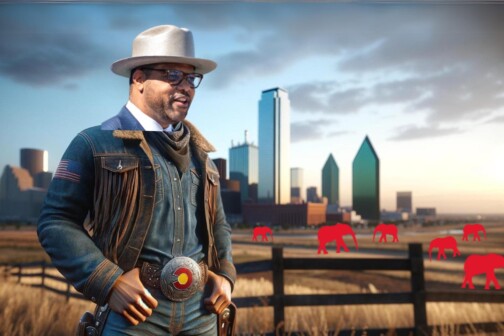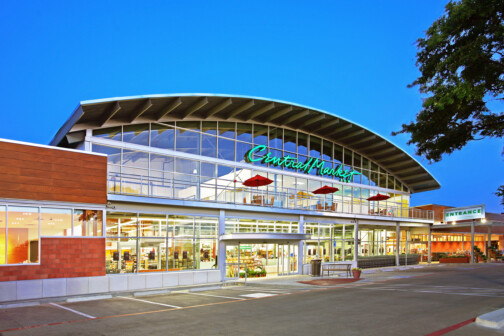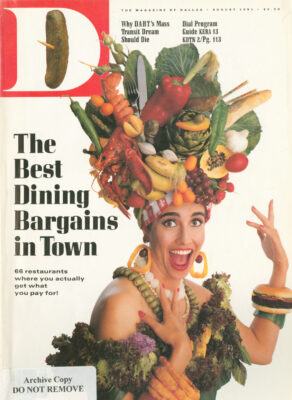FOR ALMOST TWO DECADES IN Dallas, a strange, elephant-like creature adorned bumper stickers, billboards, and the T-shirts of young adults who called themselves “Zoo Freaks. ” The creature was the logo for radio station KZEW, the station that spoke for a generation of local baby-boomers, blasting out rock ’n’ roll, defining the lifestyle of the post-Woodstock generation, and hosting huge, free concerts that filled Fair Park and Reunion Arena.
KZEW was a pioneer on the FM dial at a time when there were few FM stations and those that did exist drizzled out tranquilizing music for doctors’ offices. After a meteoric rise to the top of the rock radio heap, The Zoo completely disappeared from the FM dial and does not exist today. To look at the history of KZEW is to look at the changing profile of Dallas-and the evolution of “underground” radio into a more profitable, more cautious, less vital medium.
KZEW-FM had its birth in 1973 when Ira Lipson and John Dew came to Dallas from WWW in Detroit, where they had worked in FM rock. The duo was hired to work at WFAA’s AM station, but what they lusted after was a then little-used station, WFAA-FM, which vended “beautiful music. ” Dew somehow convinced the powers that be at the conservative Belo Corporation (The Dallas Morning News, Channel 8) to let him and Lipson try out a rock ’n’ roll format on the company’s FM signal.
At the time, of course, almost all rock stations were on the AM band because cars came with AM radios. Belo’s FM station was not doing much business with its beautiful music, so management was willing to let the “hippies” take a shot. For the price of a change in call letters, KZEW was born. One radio consultant has said that if you wanted to start an FM rock station in Dallas today, the cost would be $30 million.
Already, several FM stations in California and New York had started what was then known as underground radio, a free-form type of programming that abandoned the popular Top-40 format and basically let the DJ play and say whatever he wanted. Unlike their chatty AM counterparts, underground DJs spoke as if they were stoned and played blocks of obscure album cuts from a wide variety of artists. Between songs, the DJs would ramble on in a laid-back voice about whatever topic they chose, from the Vietnam War to Richard Nixon.
In those simpler times, radio was not as heavily researched or as corporate as today. No one had pages of research purporting to show that an audience wouldn’t listen to a station that mixed Willie Nelson, Jimi Hendrix, and Joni Mitchell. No consultants were around to say, “You can’t do that. ” So they did it.
It was in this pioneering era that The Zoo burst onto the Dallas radio scene, and the man chosen to make it work was Ira Lipson. Lipson had come up with the call letters KZEW, or “The Zoo, ” and had an artist friend of his who was dodging the draft up in Canada design the station’s logo. The idea was for the station to have both an element of the unexpected and a conscience. Lipson staffed The Zoo with diverse air personalities such as John Rody, Jon Dillon, Beverly Beasely, Mike Taylor, Ken Rundel, Mark Addy, and John LaBella.
When the DJs showed up for their first day of work, they were stopped by Belo’s security guards and denied access to the building. The guards thought that there was no way this scraggly crew of “hippies” could be working for their company. Belo officials were somewhat embarrassed that a bunch of longhairs had taken over a corner of their huge communications complex, and they did little to trumpet the fact to the general public. For the first six years that The Zoo was in existence, its name did not appear on the Channel 8 Belo sign in the lobby, there was no sign on the door of the office, and the staff was tucked away on the second floor, consigned to the older studios and production equipment. “They buried us in a closet, ” laughs Ira Lipson, who today heads his own local production company. “They gave us all of the old equipment, but that forced us to make all of the energy go out through the microphone and turntables. “
The jocks let loose with a diverse blend of music, from “Play That Funky Music White Boy” by Wild Cherry to “Cowboy Song” by Thin Lizzy. Lipson did not use a rigid play list but instead opted for a blend of the popular and the obscure, allowing the jocks to pretty much call their own tunes.
Life at KZEW was a zoo in itself. It was kind of like the Smothers Brothers on LSD had taken over a major broadcast facility, right in the heart of the Bible Belt.
“Our general working attire was whatever we woke up in, ” says John Rody, now a DJ for KZPS-FM in Dallas. “A standard dress wasn’t even a consideration. Most of us wore jeans, T-shirts, and sneakers for nine years.”
The jocks themselves lived a life of rock ’n’ roll abandon that was prevalent in the Seventies. One evening the nighttime DJ came to work drunk and kept taking swigs from a bottle of tequila while on the air. In the middle of his show he launched into a tirade, hurled a few expletives about why “this stuff always happens to me, ” and walked out of the studio. The audience was treated to nearly an hour and a half of dead air until they picked up the sounds of footsteps down the hall as the jock for the after-midnight shift walked into the empty booth. She put on a record and picked up as if nothing had happened.
There was also the time that the station threw a birthday party to celebrate a few years of staying in business and served a huge birthday cake to the staff. Unbeknownst to them, a prankster had dumped marijuana into the cake mix. Needless to say, not a lot of work got done that day.
Then there was the DJ who did not like the commercials that a client had submitted, so he simply refused to run them. The problem was that he didn’t tell anyone what he had done. Months later, during a Belo audit, the accountants discovered that the renegade jock had neglected to air nearly $380, 000 worth of advertising in a two-week period.
As for the news department, they downplayed usual stories about Dallas City Hall, the Texas Legislature, or business trends, and instead carried reports on Agent Orange, marijuana smugglers, and UFOs. On one newscast they gave the address of an agency that would test marijuana for traces of the herbicide paraquat (used by the government to discourage marijuana production) and told listeners how to mail in samples of their personal stash for testing.
It wasn’t just the rock music and the free-form programming that made The Zoo a hit. It was instead a total identification with its audience-the masses of young people who were streaming into the Dallas/Fort Worth area, attracted to the jobs that were plentiful in those days. The drinking age was 18, and hundreds of rock ’n’ roll bars sprang up to cater to this thirsty crowd. Lipson & Co. made listening to The Zoo like becoming a member of an extended family. You were either a Zoo Freak, or you were a geek.
To cement this relationship, there were hundreds of free Zoo events. There was the Zoo Goodwill Jam concert in Fair Park, headlined by Black Oak Arkansas. To gain admission, Zoo Freaks brought 110 tons of used clothing. The biggest KZEW event of all was Zoo World, a free show and lifestyle fair that grew to take over the entire Dallas County Convention Center. Unfortunately, the crowd got so large and unruly that one year the Dallas police were called in to subdue the more exuberant, and the event had to be canceled.
In October of 1983, “The Morning Zoo” scored an amazing number two ranking in the Dallas/Fort Worth radio market. It grabbed a 9. 1 share in the Arbitron ratings book and was being heard by close to a quarter of a million people daily.
“We had no grasp of what the market would bear back then, ” recalls John Rody. “If you had a show in Dallas today with a 9 share, they would pay you $200, 000 a year to stay there. Back then I was making $214 a week and thought I was rich. “
At that zenith, the Belo bosses realized what a gold mine they had. The ratings success brought a new scrutiny of The Zoo. Ira Lipson left the station and the sales staff began to take over. The idea was to start selling The Zoo to more “mainstream” advertisers instead of to the record stores, head shops, and concerts that were a part of the rock lifestyle. As part of this attempt to attract mainstream clients, the management got rid of The Zoo’s creature and started clamping down on the jocks. Besides this switch in station philosophy-from hippie idealism to bottom-line sales-the Zoo Freaks were also changing. The 18- to 25-year-olds who had been living in apartments were knocking on 30’s door, buying a house, and sporting a wardrobe that no longer included jeans and a black Led Zeppelin T-shirt. And in the early Eighties, Q-102, KEGL, KNUS, and others were fighting for a share of the pie. The ratings for The Zoo began shrinking.
What came next were what staffers called “the scramble days, ” as the station struggled to increase advertising sales and recapture the old magic. A research firm was hired to determine what kind of music should be played, and an ad agency was brought in to start a media campaign.
It wasn’t long until Belo sold KZEW-FM to Anchor Media. The staff had to move out of its old haunts in the Belo building to a new location on Hall Street in Oak Lawn. By then the thrill and the ratings were truly gone. It became quite fashionable for other stations to bash The Zoo as it went through an endless chain of DJs and format changes. The promotional budget was slashed to the bone, so much so that staffers couldn’t even get free pens or pencils.
Two weeks before Christmas of 1989, the station fired its entire staff and played nothing but Christmas music for the remainder of December. By January 1, 1990, the station changed its name to KWRM, or Warm, “Soft, Relaxing Music. ” The Zoo was no more. As of now the station is Lite 97. 9, the home of “Soft. Relaxing Favorites. ” In a bizarre twist, the station has taken a long, strange trip back to where it began- “beautiful music.”
Today John Rody and Jon Dillon are plying their trade at 92. 5-FM. where their play list contains hits from the Sixties and Seventies, and their audience contains a lot of old Zoo Freaks who are now donning a coat and tie and working in an office. Rody is somewhat philosophical about the rise and fall of The Zoo.
“You know, in the old days of radio, the jocks used to work out at the transmitter, somewhere out in the country, while the sales staff stayed downtown, ” adds Rody. “That’s what they probably should have done with us. Stuck us in some Quonset hut out by Cedar Hill and let us rock out, but that won’t happen anymore. Today you are much more aware that these ’fun and games’ represent big business, and it is a highly calculated industry.”
Get our weekly recap
Brings new meaning to the phrase Sunday Funday. No spam, ever.
Related Articles

News
White Rock Medical Center Temporarily Stops Receiving Ambulances and DFW Ranks 45th in Latest Hospital Safety Rating
Plus UT Tyler's new dermatology department, Children's Health's honor, and more.
By Bridget Reis

Local News
Mayor Eric Johnson Makes Another ‘Friendly Belt Buckle Bet’
This time its on the Avalanche-Stars game.
By Tim Rogers

Commercial Real Estate
Checking in on HEB’s Plans for the Old Albertson’s in Uptown
The property at Lemmon and McKinney remains undeveloped despite years of announcements and renderings that depicted a $295 million, 25-story mixed use development anchored by a Central Market. What's going on?
By Will Maddox


